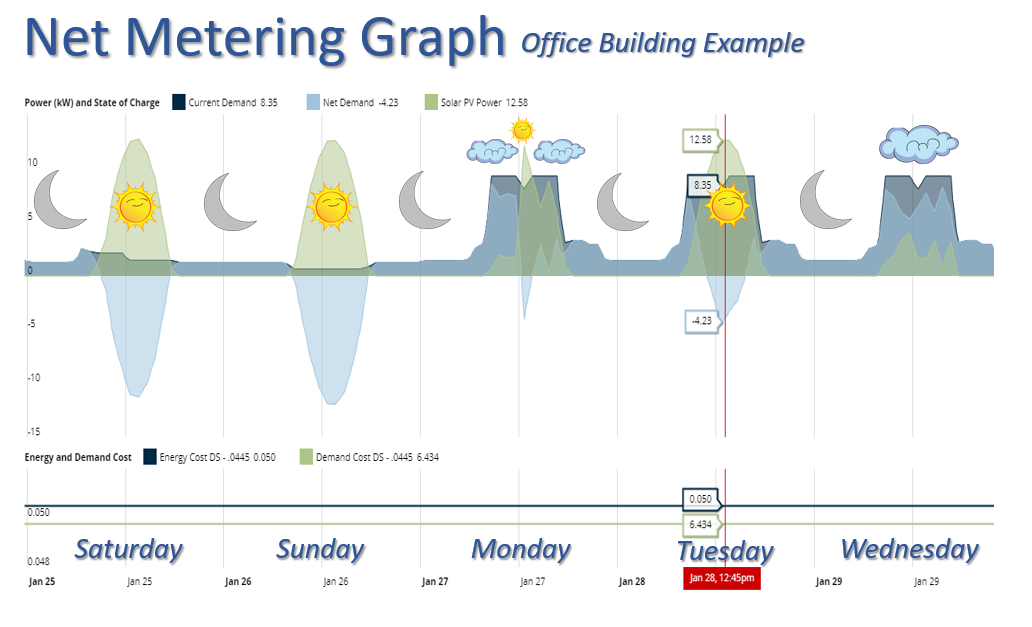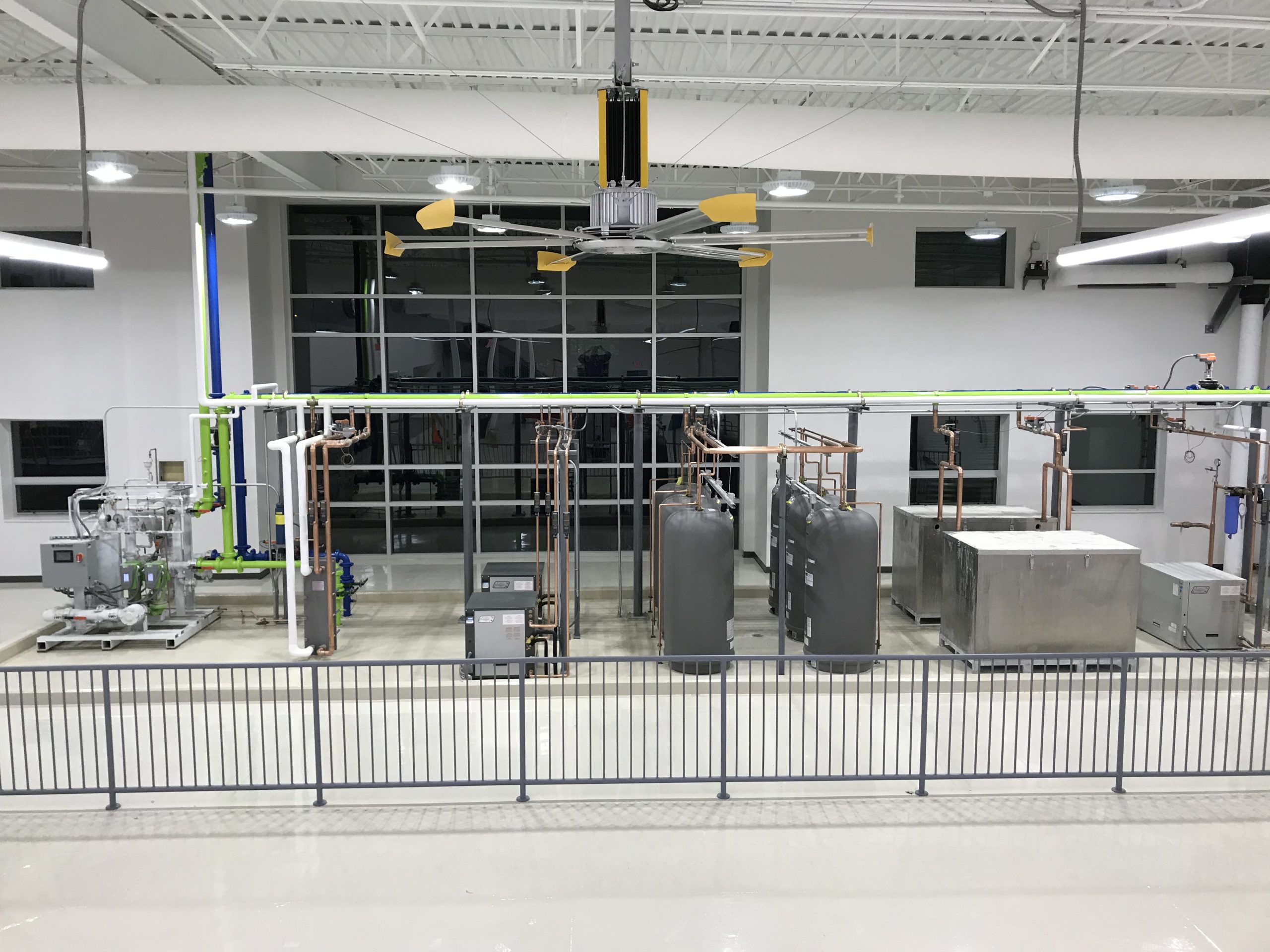If you are considering solar for your commercial building, an important concept to understand is net metering, whether it applies in your state, and how it works with your utility company.
What is Net Metering?
Net metering is a billing incentive that offers credits to the owner when a solar PV system produces more electricity than consumed. Any excess power generated through solar feeds back into the utility grid, thus qualifying the owner for a “credit” on his or her electric bill. Think of “debits” as energy used from the grid, or any electricity that solar power cannot cover during a given period.

This animation illustrates the flow of energy production when electricity is used over the day and night. During the day, the owner generates credits when the building’s solar panels produce more power than needed (net metering). The meter spins backwards, and excess electricity gets sent to the grid. At night, the building’s electricity needs aren’t fulfilled by solar due to lack of sunlight. Its power is therefore sourced, or debited, from the grid.
How Does Net Metering Work?
- Credits = Power produced by solar
- Debits = Electricity consumed from the grid
The net of these two is how net metering functions, factoring in whether the owner is charged for grid usage, or owed credits for solar production.
Think of the daily variations of energy usage in the typical home. Assume that residents typically consume most of their electricity in the mornings and evenings, before and after work. If there is little or no solar production during the time when electricity is needed, energy will come from the grid. Hence, debits — or the costs one would otherwise see on the utility bill.
Solar energy systems usually hit peak production in the afternoon when sun exposure is maximized. So, what happens to all the solar generation during the day if the power is not used or needed? The excess solar power spins the meter backwards and sends energy to the grid. Hence, these credits serve to help offset your electricity bill.
Why is Net Metering Important?
Net metering ensures the owner is credited for those natural swings in daily production. Depending on your building’s energy usage and time of peak demand, net metering can help maximize the owner’s savings from solar power. Understanding net metering laws can help determine the ideal size of the PV system, after factoring in daily, weekly, monthly, or annual estimated energy usage.
If you are considering switching to solar, these net metering regulations should guide the solar company to design your system in the most cost-effective way. After evaluating your electricity usage, the solar provider should factor in net metering compensation to get the best return on your investment, depending on how much PV generation you prefer.
How Does Net Metering Compensation Work?
Forms of compensation will vary by state and utility company. Generally, the owner should be charged only for the net electricity used by the end of the month. In some instances, if more power is generated by solar than consumed over a month or year, the utility will roll over those credits to the next period. In other scenarios, the consumer will be compensated at the retail or wholesale rate at the end of a given cycle.
Consumers must elect to receive credits in a contract with their utility provider. Tariff sheets, or compensation rates, are provided by the utility and explain whether solar overproduction results in the following:
- Monetary bill credits
- Check payments
- kWh credits to offset future consumption from the grid
It is important to fully understand your state’s policies regarding net metering compensation. EnergySage explains how net metering rules can vary: “If you do generate more electricity than you use in a year, utilities in some states will let you carry credits over into future years, while others will reduce your credits.”
Do not let credits confuse you for cash payments, unless you live in a state that allows for that type of compensation. While you can stock up on credits to cover power you may need from the grid throughout the month or year, do not assume the utility companies will be sending a check covering the full retail rate.
Does Every State Have Net Metering?
While net metering is authorized in most states, there are different approaches to how they distribute credits, assign eligible technology, and handle capacity limits. The National Conference of State Legislatures expands on state-specific laws and advises one cannot make assumptions about compensation without digging into state rules. For example, “California credits excess generation to a customer’s next bill at retail rate. After a 12-month period, customers can choose whether to roll credits over indefinitely or receive a payment for credits at the wholesale rate. If no option is selected, credits are granted to the utility with no customer compensation.” In this case, the owner can opt in for credits at the end of the year, but it will be at the wholesale rate. Month to month, however, they receive credits at the retail rate.
Net metering policies were originally intended for areas with lower solar adoption. As more and more states become reliant on clean energy, we can expect some changes to occur. Regardless of your state or utility’s current policy, it’s important to understand how different factors can affect your long-term savings when installing solar panel systems.
Does Net Metering Eliminate Utility Bills?
A common misconception is that if you can attain Net Zero Energy for your building, you will not receive a utility bill. This is false, as the owner is still tied to the utility company in some capacity. If you are producing a lot of solar power, the building consumes the amount of electricity needed, and the remaining power shoots back onto the grid. Credits are accumulated through net metering and impact whether your utility bill is $0, or a lesser amount than in the past.
Sure, you may owe less to the utility, and the bill may look different depending on how much energy solar can offset. However, in most cases, solar will supply as much electricity as possible, and the remaining power is met by the grid.
How Does Net Demand Work?
The following chart shows a live example of how net metering works when savings occur with solar PV generation. These daily variations in current demand (debits), layered against solar PV power (credits), result in the building’s net demand.
The solar energy system at this site overproduces during the first two days since there is ample sunlight and little demand. The utility is crediting the owner’s account for that overproduction, which is then used to offset the bill when the system is under-producing.
Net metering occurs in the areas that display overproduction from solar. Excess electricity causes the meter to spin backwards. In these cases, solar generates more power than the actual usage. That excess power is sent back to the grid, while “credits” accumulate on the account.
Savings occur in every green area where solar produces power. For example, although the system is not overproducing during the last day, solar is still helping to offset part of the demand costs, or “debits.”

WEEKEND: On Saturday and Sunday, the building load is very low. Solar power is generated throughout the day with plenty of sun, which causes a lot of energy to be exported to the grid (accumulating credits). Credits are being used up at night while there is still some electricity load.
MONDAY: The building energy load spikes, causing debits on the account. Solar generation doesn’t show a consistent curve since it’s cloudy outside. For the most part, the building is pulling power from the grid (at a reduced rate), and energy is exported for a small amount of time in the middle of the day.
TUESDAY: A nice, sunny day. In the morning, the building starts pulling power from the grid as the energy load shoots up when workers arrive. Then, the load from the grid starts to slowly reduce as some of the electricity is produced by the solar array. Then, eventually, the building exports power back to the grid (accumulating credits), before the cycle reverses again.
WEDNESDAY: No net-metering occurs because of the lack of sun. However, the load from the grid is reduced and savings still occur. The net of the debits and credits appears in the middle.
How Do I Learn More About Net Metering?
Net metering can be a confusing subject. The experts at Melink Solar & Geo can help you navigate the jargon and determine the best solution for your business. Leave a comment below.



